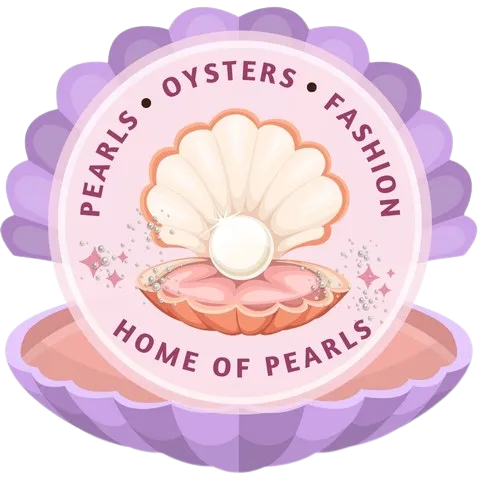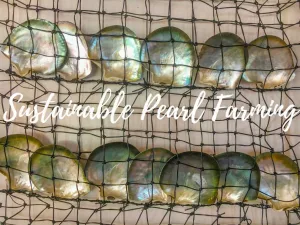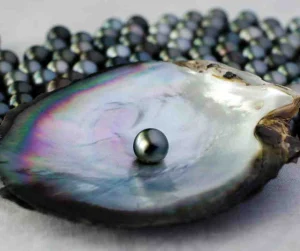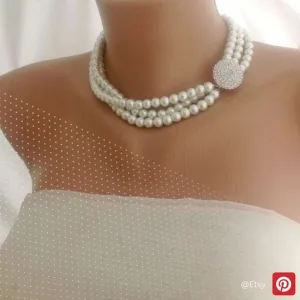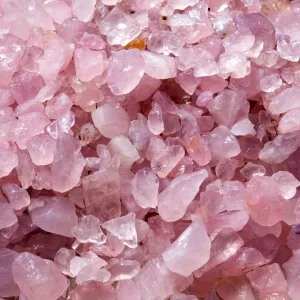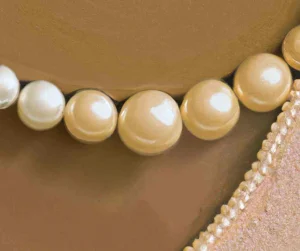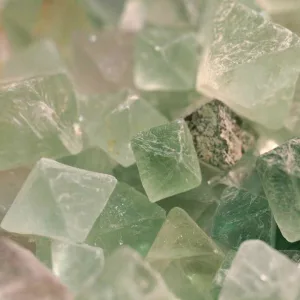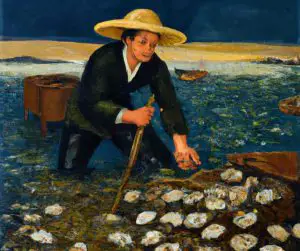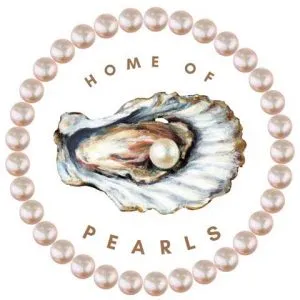The word ‘Keshi’ is a Japanese word meaning the smallest particle imaginable, e.g., a grain of sand, poppy seed, etc. In the Japanese pearl business, it is slang for the by-product of any oyster seeded for culturing.
It is not in itself natural, being caused by the act of operating on a live oyster.
Keshi pearl refers classically to the culturing of pearls from Akoya oysters and hence has loosely also been used, perhaps mainly in Japanese, to describe all non-nucleated pearls produced, either as a result of culture or else deliberately as opposed to being a natural product.
Table of Contents
- The process of forming a Keshi Pearl
- The Shape of Keshi Pearls
- How Big Are Keshi Pearls?
- Saltwater keshi
- Freshwater Keshi
- Comparison of various Keshi Pearls
- Are Keshi Pearls Expensive?
- Are Keshi Pearls Real?
- Are Keshi Pearls Rare?
- In Closing
- Reference
The process of forming a Keshi Pearl
The process of inserting a nucleus with its surrounding ‘mantle piece’ (epithelial tissue) into Pinctada martensi (a species of oyster) can cause Keshi formation.
With the insertion of a nucleus into the gonads of an oyster, the incision itself, plus the piece of mantle tissue inserted, can both cause the formation of small cysts (fluid-filled sacs) producing small pearly baroque ‘pearls’, varying from 1 to 4mm.
Types of oysters used in pearl culture
- Akoya oysters (P. martensi)
- Silver-lipped or golden-lipped (P. maxima)
- Black-lipped (P. margartifera)
- Black-winged pearl oysters (Pteria penguin)
This surgery on the flesh of the living oyster causes it to produce, within its organs, other tiny and small pieces of pearl apart from the prime cultured pearl.
This process of stimulating the additional growth of pearls without a nucleus is an additional goal of the operation. These additional pearls are known as ‘Keshi’ and consist of (usually) baroque-shaped small sizes of solid pearls (typically under 5mm).
Although in larger sizes, there may be a hollow at the center, reducing the quality of the pearl. Without this unique operation, the oyster would not produce more than a few pearls.
Also, Keshi, being pure pearl, responds quite favorably to bleaching and treatment. Indeed, finished pearls are often lustrous, bright, white, and attractive.
The Shape of Keshi Pearls
The shape of keshi pearls will be a bit different than you might expect. Instead of being spherical or half-spherical, these pearls will be different shapes and sizes.
They form naturally and it’s not unusual for these pearls to be long and thin. They can also be smaller and look like imperfect spheres.
Since the shapes and sizes of keshi pearls differ greatly, they’re often used to make unique types of jewelry. They can be used to make bespoke designer jewelry. Often, people who use keshi pearls to make jewelry do so to make one-of-a-kind items.
The organic shapes of these pearls are so unique that they will have a special appeal to those who want to stand out.
How Big Are Keshi Pearls?
Above, you learned that the shape of these pearls can differ wildly. You’ll also find that keshi pearls come in a wide range of sizes. Generally, these pearls will grow to be between 2 and 10 millimeters in size. It’s possible that some keshi pearls might be slightly larger than this.
These pearls usually don’t grow to be incredibly large, though. Even the larger 10 millimeter keshi pearls would be considered to be smaller than most other common types of pearls.
They’re small in size because they don’t have nuclei that help them to grow larger. Keshi pearls are simply excess nacre that formed into pearls.
Some keshi pearls such as the Akoya keshi pearl are even smaller. These pearls are only between 1 and 3 millimeters in size.
So you can see that these pearls are a bit on the small side. That doesn’t make them any less gorgeous or sought-after.
Saltwater keshi
An operation on P. maxima of various lip colors also produced a ‘Keshi’ of sizes typically larger than Akoya (type of pearl).
Golden-lip shell yields a creamy-tone Keshi, while a black-lipped oyster produces a grey-tone Keshi. Interestingly, larger sizes of these pearls are sometimes sold as natural pearls.
Due to their lack of a nucleus, these pearls can bypass detection by X-rays and may be sold to unsuspecting buyers as “veritable natural pearls.”

Freshwater Keshi
In Lake Biwa, Japan, and in certain river areas in China, there is a regular production of Keshi pearl. In Japan the mollusk is a mussel, Hyriopsis schlegeli.
First, small pieces of flesh are inserted into the animal, with the result that for the first year, good quality Biwa Keshi is produced.
This initial yield of Keshi is harvested from the mussel without the host being killed or even noticeably harmed. This delicate process allows additional harvests in the future.

Injections by syringe of glucose or vitamins are sometimes made, but this is not universal. The second crop is duller and flatter than the first, whilst the third-year crop is very thin, even like slices of pearl, lustreless and dirty, and it is often used for grinding into medicine.
The Japanese pump air into the mussels’ pearl sacs to produce these sacs’ long stick-shaped pearls. By combinations of flesh and air pump, fancy shapes of Keshi are also made, such as flats, ovals, and even squares.
The vast majority of fresh-water Keshi are made into uniform strands, which are then treated into many different colors and sold easily worldwide.
Comparison of various Keshi Pearls
| Shell type | Trade name | Identification |
| Pinctada martensii (Akoya) | keshi | beadless cultured pearl |
| Pinctada maxima | South Sea keshi | beadless cultured pearl |
| Pinctada margaritifera | Tahiti keshi | beadless cultured pearl |
| Cristaria plicata | freshwater pearl | beadless cultured pearl |
| Hyriopsis cumingi | freshwater pearl | beadless cultured pearl |
Are Keshi Pearls Expensive?
If you want to buy keshi pearls you should expect to pay quite a bit of money. These pearls are generally considered to be quite pricey. They’re expensive because they’re lustrous and truly beautiful. Also, they aren’t as common as some other types of pearls.
Keshi pearls only form when there’s an excessive amount of nacre in the mollusk. These pearls form as a byproduct of standard pearl cultivation. As a rarer and more sought-after pearl type, it’s going to cost a bit more money to get keshi pearls. You’ll find keshi pearl jewelry being sold for thousands of dollars at various jewelry stores.
These pearls are prized possessions for many people. If you have the chance to buy keshi pearls, it’s possible that they might become your favorite jewelry item. Many people have fallen in love with the unique appeal of keshi pearl earrings and necklaces over the years. Jewelers create interesting pieces using keshi pearls, and it makes sense that these jewelry items would cost a fair bit of money.
Are Keshi Pearls Real?
Yes, keshi pearls are considered to be real pearls. They’re pearls that are 100% nacre, and they don’t have a nucleus. It’s true that keshi pearls are different from standard types of pearls, but they’re still considered to be real pearls. They’re small by most standards, but they’re lustrous and incredibly beautiful.
Are Keshi Pearls Rare?
You’ll find that keshi pearls are quite rare. Finding keshi pearls isn’t easy and the scarcity of these pearls helps to keep them expensive. Also, they’re unique because they come in different sizes, weights, and shapes. The differences help to make each keshi pearl uniquely rare and valuable.
For many, keshi pearls will be a bit too pricey. Even so, it’s easy to see why these rare pearls are so appealing.
They look fantastic and they can be used in so many interesting ways to create jewelry items. They’re among the most well-loved pearl types that you’ll find.
In Closing
Knowing more about keshi pearls should help you to understand just how interesting they are. These pearls are truly special because they’re formed entirely of nacre. They’re rare pearls that form from excessive nacre in mollusks. Each keshi pearl will have a slightly unique shape and size.
They’re commonly used to make jewelry items, but the pearls themselves are anything but common. Since these pearls are rare to find, they’re going to cost quite a bit of cash.
For some, they might be too expensive, but many will appreciate their beauty. If you see keshi pearl jewelry being sold at a local store you might want to consider buying some if the items are in your price range.
Reference
Hänni, H. A. “A short review of the use of ‘keshi’as a term to describe pearls.” Journal of Gemmology 30.1/2 (2006): 52-58.
